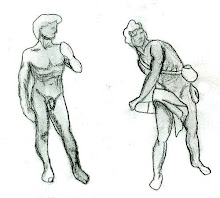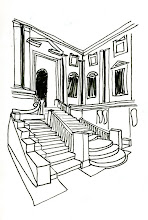
[re] vision:
An example of a great architect with extraordinary vision is Frank L. Wright. He has more than proven himself over the years in his accomplished works. For instance; when creating the Robie House he saw that the city near by was full of modern design and vertically reaching buildings. He wanted to bring the family/ home life back to its pioneer origins. So he then created a horizontally reaching home. But that’s not all Wright also decided that he was going to accentuate the horizontal values by the brick lay of the structure he even planned to have two different color types of mortar; one for the vertical and one for the horizontal spaces.
Roth (2007), “Other architects, possessed of unshakable self-comfidence and guided by a unique vision, simply invented their own idiom. Of these individualist architects the American Frank Lloyd Wright (1869-1959) was one of the very few who developed a philosophy of design capable of being unfolded throughout his long life.” (p.462-463)
In Wrights philosophy of design, he believed that the fireplace is the hearth of the building. Take for example his western Pennsylvania home, Falling Water, many will agree that the fireplace is the most extraordinary moment in that home. As far as vision goes, Wright had created the home with darkened hallways this way the occupant would be almost unwillingly pushed through the home and into the lighted living space. This was because Wright saw hallways as simply a passage way. Rooms were designed to be lived in not past through.
An example of a great architect with extraordinary vision is Frank L. Wright. He has more than proven himself over the years in his accomplished works. For instance; when creating the Robie House he saw that the city near by was full of modern design and vertically reaching buildings. He wanted to bring the family/ home life back to its pioneer origins. So he then created a horizontally reaching home. But that’s not all Wright also decided that he was going to accentuate the horizontal values by the brick lay of the structure he even planned to have two different color types of mortar; one for the vertical and one for the horizontal spaces.
Roth (2007), “Other architects, possessed of unshakable self-comfidence and guided by a unique vision, simply invented their own idiom. Of these individualist architects the American Frank Lloyd Wright (1869-1959) was one of the very few who developed a philosophy of design capable of being unfolded throughout his long life.” (p.462-463)
In Wrights philosophy of design, he believed that the fireplace is the hearth of the building. Take for example his western Pennsylvania home, Falling Water, many will agree that the fireplace is the most extraordinary moment in that home. As far as vision goes, Wright had created the home with darkened hallways this way the occupant would be almost unwillingly pushed through the home and into the lighted living space. This was because Wright saw hallways as simply a passage way. Rooms were designed to be lived in not past through.

Audience:
Audience consists of a group of individuals who are observing an object or process. As the statement below from Roth Understands Architecture suggests, Frank L. Wright was absolutely catering to his audience in creating a home that would be different from work and suitable for living.
Roth (2007), “Wright exaggerated the horizontal lines to integrate his houses with their prairie settings, creating a strong connection with the earth.” (p.498)
In another section of Understanding Architecture Roth (2007) goes on to say, “the tiny room accommodating the staircase up to Michelangelo’s library is crammed with dark, massive architectural elements contrasted to the white walls. (p.383) This statement is refers to the library steps created by Michelangelo. Through my studies I have learned that these steps were created the way they were not just to be visually pleasing and delightful but also to symbolically represent the difficulties and hardships one takes on in the journey of gaining greater knowledge.
Character:
Roth (2007), “The Gothic alternative in this more creative phase of nineteenth-century eclecticism has come to be called High Victorian Gothic, because of its elaborate character… The colorful character of the profile is enriched by the multiple colors of the building materials, including red brick, stone, slate, and marble of various hues in the polished columns.” (p. 435) As we progress through our academic studies we learn that each genera is classified by its own character or sense of style.
Transition:
Roth (2007), “Guided by thee philosophes, European architects by the mid-eighteenth century began to reject the visual excesses of Rococo architecture in favor of a structural discipline shorn of extraneous ornament: the generative basis of architecture was transformed.” (p. 418) Like in any change, in the architecture world there is a transition from genera to genera and culture to culture.
Datum:
Datum is the measurement of something. So I have decided to measure the similarities and differences between Bernini and de Vinchi’s David. De Vinchi’s David was constructed first. This piece illustrates David leisurely standing with one hand resting on his shoulder. He appears to be reminiscing the fight that recently took place. In size his hands and head look disproportionate to his body. As for Bernini’s David: the sculpture possesses more fluidity and appears to be in the fight. Also this David is clothed and more accurately scaled to the human figure.
Reflection:
Whether it be the precision one takes in making accurate measurements or pleasing their audience, a designer’s charter will always shine through to their final product. This is way it is absolutely necessary to have a clear vision and a smooth transition form each step of design.










No comments:
Post a Comment